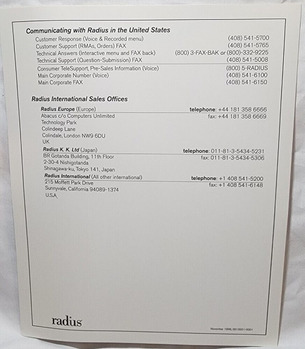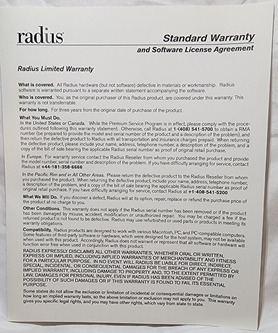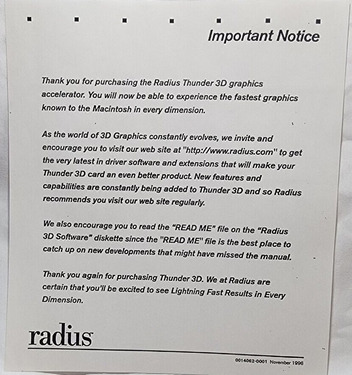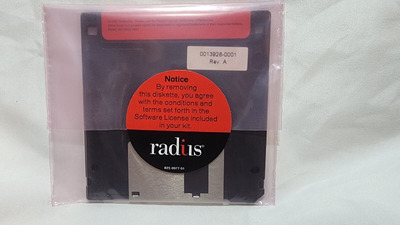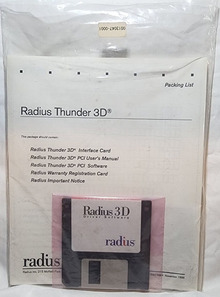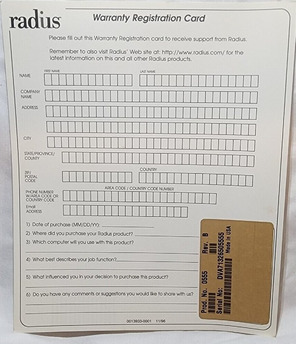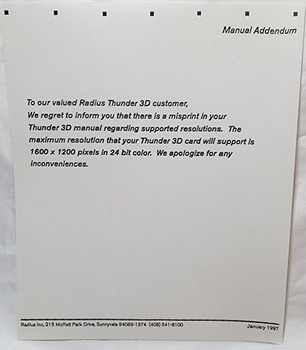After some test, i can say that the Thunder 3D will not work with G4 CPUs. The computer will not even start. G3 CPUs will not work ell either and i have encountered issues with performance when using such CPUs. These problems could stem from clock speed or instruction set. For example: a 500MHz G3 (1M L2 250MHz, 1M L3 50MHz) equipped 8500 PowerMac will only reach 100 KTris/s when rendering a gouraud shaded plane. The same computer equipped with a 250MHz 604e CPU (1M L2, 50MHz) will archive >300 KTris/s in the same test. I can speculate that the CPU is sending data to the Glint Delta too fast? In early 1997, there were only 200-300 MHz CPUs (6042 G3) available. The latest OS the card could ever be tested with would be Mac OS 8.0.
All in all, i am disappointed in the performance of the card. As i stands now, in textured scenes it does not even archive the performance of a single Quickdraw 3D accelerator that was released 15 months prior. It is much more powerful in untextured tasks like flat shading or gouraud shading. It comes close to a Rage Pro in regard of pure calculating power of polygons (in synthetic benchmark) but lacks the pixel throughput to get the picture on the screen.
The highest numbers i could get were:
(deep Z-buffer, True Z, perspective correction, interpolated blending, no backfacing, single buffer)
17 Mpix/s gouraud shaded (5.5x faster than a 604e 250)
320 Ktri/s gouraud shaded (3.5x faster than a 604e 250)
10 Mtex/s unfiltered textured (3x faster than a 604e 250)
120 Ktri/s unfiltered textured (1.7x faster than a 604e 250)
The dithering in 16bit is very noticeable and much worse that the software dithering. It nearly looks like 8bit graphics.
My thoughts about this card:
It has barely matured drivers. The company "Radius" did release another 3D capable graphics card afterwards based on the Permedia NT chipset (Glint Delta+Permedia). That card never received any updates and i have never seen it in the wild. Radius steered towards Firewire products and Video-editing/capturing for 1998 on. The graphics card part of the company was closed later on and the digital video part was renamed.
The Glint delta+500TX chipset is quite capable in terms of raw calculation but lacks the "pixel power" needed to leave an impression. The drivers may be one of the reasons for the lacking performance but i think that the texturing part of the render pipeline is just not capable enough. Any game from that time will not work correctly due to driver issues and low frame rate. It might have had a place in professional environments where texturing was not part of the workflow of 3D construction and design. The missing OpenGL support is strange but may come from the late availability of the OpenGL interface to Mac OS and radius leaving the market. All in all, the card was not a good purchase in 1997 and even mid-level graphics cards had better features, were faster and had better support. The complete lack of any configuration utilities to use the propagated features (like 30bit color) is baffling. When the card was dropped from $3000 to around $1500 $2000* in mid late** 1997, ATI released the Rage Pro based XClaim VR+ for about $400. The ATI card was faster in 2D and 3D and had excellent drivers and support.
The card is a strange creature born from high expectations and a complete misunderstanding of the market.
*, ** corrected 19.12.23 20:38
-Jonas
